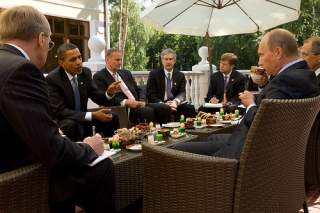America: Choose Your Enemies Wisely
"Getting it wrong can lead to serious, damaging consequences."
Does America, the world’s dominant power since 1945, face such challenges that define new enemies? Is Russia one? What about China?
Many neoconservative and Wilsonian thinkers in America today believe that Russia represents such a geopolitical threat, and if America doesn’t respond, the result will be a new Cold War reminiscent of the last one with the expansionist Soviet Union. This is ludicrous. It isn’t Russia that has been expanding its influence and reach to the west in provocative ways but rather America and the West, expanding to the east. As George Friedman has noted, St. Petersburg, the jewel of Russian culture, was a thousand miles away from NATO troops in 1989. Now it is just 100 miles away. In 1989, he adds, Moscow was some 1,200 miles away from the limits of Russian power. Now that distance has shrunk to 200 miles.
Writing in 2009, Friedman added, “Ukraine and Belarus are everything to the Russians. If they were to fall into an enemy’s hands—for example, join NATO—Russia would be in mortal danger….From the Russian point of view, NATO expanding into Ukraine threatens Russian interests in the same way as if the Warsaw Pact had moved into Mexico.”
Thus, we can see that Russia’s recent actions in the face of NATO’s eastward expansion have been largely defensive. Given its geopolitical position, vulnerable to land invasion, it feels it needs buffer zones for protection. Since its 1989 Cold War defeat and the Soviet collapse two years later, it has been losing buffer zones. Any restoration of amicable relations between Russia and the West will require Western assurances that its eastward push will cease.
This is not to say that Russia doesn’t pose any kind of potential threat to Western and American interests in the longer term. Its appetite for buffer zones is going to be voracious, given its intrinsic vulnerability, and Europe is going to have to buck up its defenses as a counterweight to Russian ambitions. Whether Europe is capable of pulling itself together sufficiently to do that remains an open question. But in the meantime, East-West stability is possible through recognition of the status quo and Western promises to refrain from further eastward expansion.
That is important not only from the standpoint of Europe’s energy needs, most of which are satisfied by Russia, but also in terms of America’s most serious threat to its global ambitions—namely, the rise of China. Here we have a situation that truly could develop into a major confrontation of the kind that embroiled Rome and Carthage in ancient times, and Britain and Germany in the twentieth century. America has enjoyed hegemonic status in East Asia since 1945. China seems resolved to challenge that status. By all appearances, it wants America pushed back to Hawaii. By all appearances, America has no intention of accepting that kind of geopolitical rollback.
If this drama unfolds as history suggests it might—with China an avowed and recognized enemy of the United States—then it will be important that Russia be a nonenemy. Just as President Richard Nixon brilliantly played China off against the Soviet Union in the 1970s, America would be wise to play Russia off against the Chinese in any future U.S.-Sino confrontation.
Thus, we see in stark relief the imperative that nations wisely and realistically identify their adversaries and enemies. Getting it wrong—either by ignoring the emergence of adversarial challenges or seeing dragons where none exist—can lead to serious, damaging consequences. The United States hasn’t been particularly adept here in recent decades, and the negative consequences are piling up.
Robert W. Merry is political editor of The National Interest and the author of books on American history and foreign policy. His most recent book is Where They Stand: The American Presidents in the Eyes of Voters and Historians.

